Did you know that there is no foot like a foot. It carries up to five times the weight of the body during running, some people are afraid of their own feet, and the shape of the foot says a lot about a person's character? We bring you interesting facts about the functioning of the human foot in cooperation with physiotherapist Sonia Barvenčíková from Fyzionožka.
20 interesting facts about the human foot
The human leg is made up of 26 bones that connect at 33 joints and are joined by 107 ligaments. In order to function properly, the leg needs to work as a shock absorber and a lever at the same time. Although we hide our feet in socks and shoes most of the day, there are many interesting things to learn about them:
1) A foot is not a foot
When we say "leg" (the human leg, not the table leg), most people think of the lower body in general. However, health professionals refer to the part from the hip joint to the foot exclusively as the "lower leg", and by "leg" they mean only the lower part of the lower limb, the foot area.
2) The human foot used to look different
Monkeys have a wider foot with a separate thumb for gripping. Our distant ancestors had similar ones before they started walking on two legs.
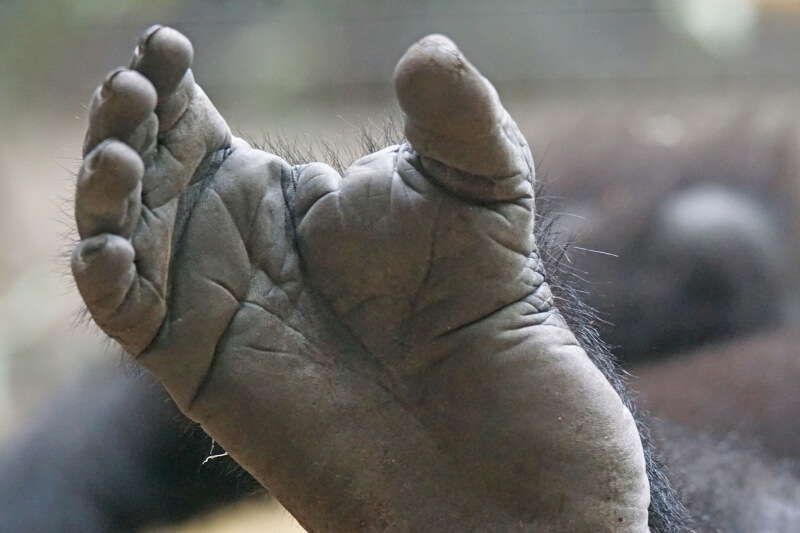
With the shift to the upright position, however, the centre of gravity became flush with the body, the reduced sole of the foot was sufficient, the thumb became aligned with the other fingers and lost its gripping function, the heel bone rotated and significantly thickened, the foot arch was formed and the hands relaxed.
3) The legs rely on the arches
The foot arches help to protect the soft tissues of the foot, prevent compression of the muscles, blood vessels and nerves in the foot and promote flexibility of the leg, allowing a soft and flexible footstep. The entire system of the foot arches is maintained by the relative ratio of the inner (medial) and outer (lateral) column of the leg bones, the tension of the muscles and ligaments of the leg and tibia. We discuss the functioning of the arch in more detail here.
4) The foot arches support themselves
Even the foot arch is built on the principle of the arch holding itself up, similar to architecture. The individual bones are wedge-shaped on top of each other, forces from the arches are applied to the arch (or the highest bone) and the arch is then forced back.
5) The foot arches divide into spokes
You may know that we divide the arches of the foot into longitudinal and transverse. In reality, we have innumerable arches, because in three-dimensional space they are divided into spokes, of which we can fit many side by side.
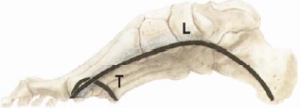
In the longitudinal arch, the apex of which is the tibia, we distinguish two spokes which start close together and fan out. The medial spoke is higher and consists of the union of the talus, the articular, the transverse cuneiform and the three adjacent humerus bones (first to third). The lateral spoke is lower and consists of the calcaneus, the cuboid and the two remaining humerus bones (fourth and fifth).
The transverse arch, which is most convex in the region of the middle cuneiform bone, starts at the occipital bones and continues to the forefoot. It can be seen, that the transverse arch is not one, but we could piece together one transverse arch after another in the course of the middle part of the leg.
6) The arches are supported by a stirrup
Ligaments alone would not hold the bones of the arch together, so the arches are supported by a tendinous stirrup formed by the attachment tendons of the tibialis anterior muscle and the calfis longus muscle. The stirrup then supports the leg in a similar way as the foot is in the stirrup when riding a horse.
7) Foot stability is provided by 4 points
The stability of any body is provided by support at three points of support with the centre of gravity between these points, which is why we often speak of a 3-point support for the foot. Specifically, we are referring to the heads of the 1st and the 5th metatarsal bones (metatarsus) and the calcaneal spur. Recently, the prevailing opinion is that the foot leans on 4 points (4-point support). The heel bone is such an important structure that the foot rests on both its inner (medial) and outer (lateral) bumps. It is between these two supporting bumps and the two heads of the calcaneus that the foot arches extend.
8) The thumb dominates the foot
The big toe not only stands out visually as the largest (and usually longest) toe, but also plays a crucial role in the proper functioning of the foot. Firstly, it provides important support for the body, but at the same time the foot bounces off it when walking or running. When the toe is off its axis (due to bad shoes, injury, improper walking, etc.), the alignment of the foot and the ability of the toe to perform its function changes. Since the feet are the imaginary foundations of the whole house, problems with the thumb can be transmitted to the whole body.
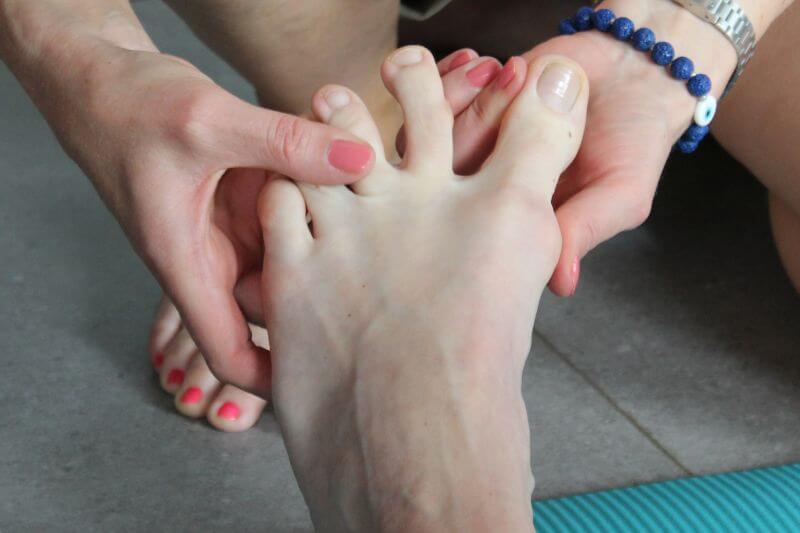
9) The thumb is connected to the cervical spine
Does your neck seem too far from your thumb? Then you should know that these two areas are connected by muscle chains. Toe mobility affects the functioning of the spine, and migraine headaches can also be related to toes. Don't be surprised if difficulties in the upper half of the body are related to problems in the foot area. We discuss the overall interconnectedness of the body more in this article.
10) Even the little finger carries great significance
Although it is the smallest toe, the little toe also plays an important role in supporting the foot. Unfortunately, this is a toe that is woefully neglected by most shoes (except for barefoot shoes, which are roomy in the toe). Crushing the little toe to the other toes often leads to buckling, and the loss of support subsequently causes the transverse arch to collapse.
11) The weight of the body is multiplied during movement
We have already mentioned the importance of the thumb in rebounding, but absorbing force when stepping is also key. The foot must first align itself with the surface it is moving on, and finally roll and bounce properly over the toe. The thumb carries twice as much weight as the other fingers when bouncing. During walking, the foot carries up to 1.5 times the weight of the whole body, during running even 5 times. So there is a relatively large cumulative force on the feet.
12) You prevent pain by maintaining momentum
It is important for the proper function of the foot to have mobile toes, heel, not to have stiff joints. The foot must absorb the load properly and flex well. All these aspects prevent painful arches and overloading of the plantar fascia.
13) Legs need regular relief
The feet are relieved in elevated position after whole day standing on them. Lie down against the wall, raise your lower limbs and lean them against the wall. Try to do a shoulder stand, which you know from gym class or yoga. It's good to get the blood vessels moving by twisting your ankle, stretching or pulling in your toes, even in a raised position. Putting on adjustable socks will also help your feet.
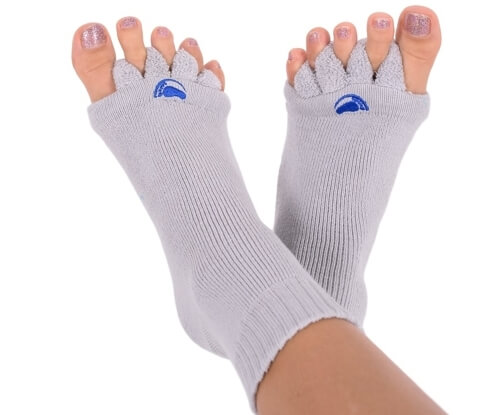
14) Massaging the feet helps
Feet suffer if we forget to take care of them, leaving them in socks and shoes all day. That's why we should regularly take the time to take proper care of them, at the very least paying extra attention when bathing. You can find many care products in the drugstore, and it is worthwhile to leave your feet free of shoes and socks for part of the day. Also try a massage, either with your hands or through stimulating aids.
15) Some people reject their feet
Strange as it may seem, there are individuals who refuse to touch their feet. They think of their feet as a distant part of the body where external stimuli are unpleasant. This phenomenon is already present in children and is accompanied by a reluctance to take off shoes or socks. However, many problems arise from untreated feet, and not only skin problems.
16) The foot can be examined with a variety of devices
As time progresses, the means by which the feet can be examined are improving. We don't have to be satisfied with only an optical evaluation or the touch of an expert, because various instrumental examinations are offered. Let us mention the podoscope, the plantograph, the digital analysis DigitsolePro or the pedobarographic platform. Instrumental examinations provide very valuable data for the puzzle.
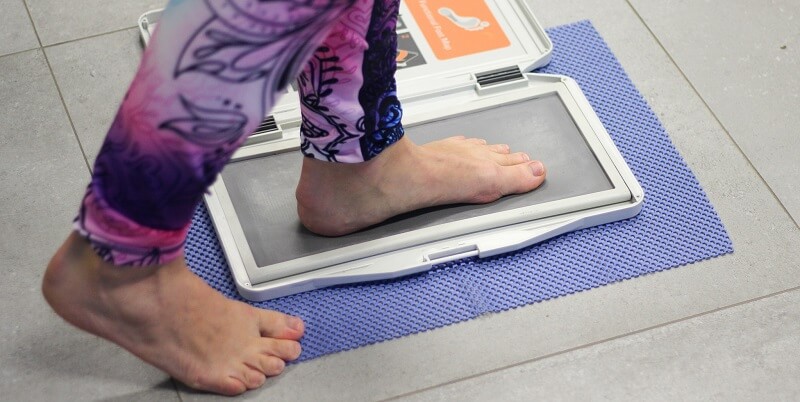
17) Even myths contain an element of truth
It is no secret that the name "Achilles tendon" comes from the mythical hero of ancient Greek myths. Achilles was soaked in the river Styx by his mother after birth, which was supposed to make him invulnerable. However, as his mother had to hold her son by the heel area during this procedure, the tendon of the calf muscle became his only vulnerable spot, where he was later hit by an arrow.
The phrase "ruined achilles = death" also has validity from the wars. Whoever had his achilles cut by the enemy probably died like Achilles, because he was unable to walk, i.e. to move on the battlefield. Nowadays, athletes, especially runners, should beware of Achilles tendonitis. Achilles problems are often closely related to the foot, and ladies wearing high-heeled shoes often suffer from them.
18) You can find Morton, Lisfranc and Chopart on the leg
You may hear the term Morton, Morton's foot or Morton's neuroma in connection with the foot. It takes its name from W. T. G. Morton, an American dentist and pioneer of anaesthesia. Morton's neuroma is a growth on the nerve endings in the area most commonly between the third and fourth metatarsal bones. This swelling is very painful and uncomfortable when it is pressed, radiating an electric pain from it. If the individual has a transversely flat foot, it will be very uncomfortable for him.
Then Morton's foot means that the individual has a second toe longer than the first toe, due to the longer second metacarpal bone compared to the thumb. This change causes the fulcrum and point of rebound to shift from the thumb to the index finger. The reflection is therefore insufficient, the individual is prone to bunions, the transverse arch decreases, blisters appear on the foot in overloaded areas, etc.
Besides Morton, we can find Lisfranc and Chopart on the leg. The Lisfranc joint is the articulation between the metacarpal and humerus bones, where it forms a functional unit. It is named after J. Lisfranc, a French surgeon and gynecologist. The Chopart joint is the articulation between the hock and heel bones with the metacarpal bones. It is named after F. Chopart, a French surgeon who performed amputations in the metatarsal joint. The joint line is S-shaped and is important for the flexibility of the whole foot. Although Chopart himself never mentioned this amputation, his contemporaries made him famous.
19) There are different toe shapes of the foot
Are you familiar with the term Egyptian foot, Greek foot or Roman foot? These are the three main toe shapes most commonly found among Europeans. There is also the Germanic foot, the Celtic foot and others. According to the shape of the foot we should focus on the choice of appropriate footwear, we discuss the foot types in more detail here.
The Egyptian foot is the most represented in the European population. It has a dominant (longest) toe and the rest of the toes descending, so this shape of the foot presents ideal conditions for proper load distribution. The Greek foot is dominated by the second toe, which takes the load. Such a foot should be treated as a preventive measure to avoid the development of difficulties (see Morton's foot). The Roman foot has the first three toes of equal length, which is also not ideal for load transfer.
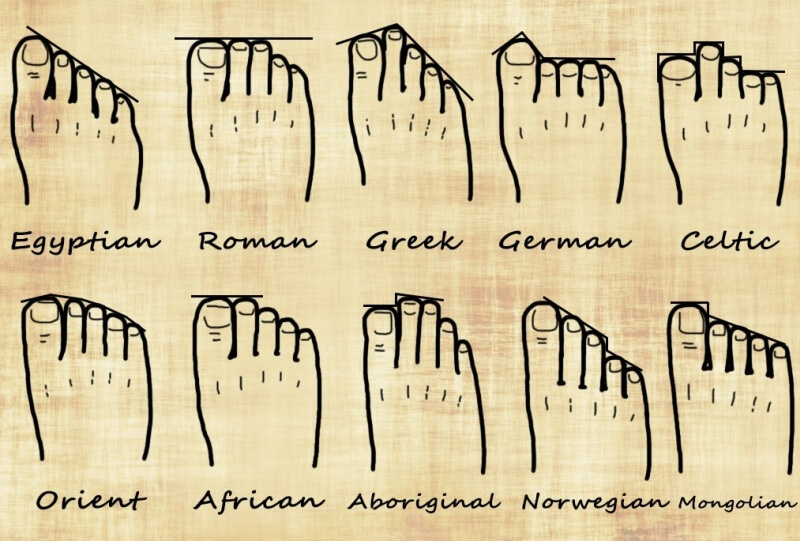
For lightness, it can be mentioned that some sources assign certain personality characteristics to the individual foot shapes. The Egyptian foot is said to be possessed by friendly romantics with a love of nature, but who are often protective of their privacy and tend to postpone responsibilities. Greek fingers are said to be worn by creative individuals with an active, sporty nature, who are often internally sensitive and stressed, although they do not show their emotions as much. Roman toes, on the other hand, mention sociable people with a balanced personality who like to learn, but often want to have things their own way and do not like to adapt. It should be added that different sources differ in their predictions, so do not give much weight to such claims.
20) Shoe shapes are constantly evolving
Shoe shapes evolve over time, there are changes in trends in what shoes to wear and which are no longer suitable for the foot. In the past, people suffered for beauty, wore small shoes and voluntarily deformed their feet. However, more and more of the population is paying attention to the proper function of the foot, we choose shoes not only according to size (length), but also other parameters (width, flexibility, flat sole, ...) to give our feet the best. Fortunately, Barefoot shoes are becoming common knowledge and we can only recommend them in the context of healthy footwear.
